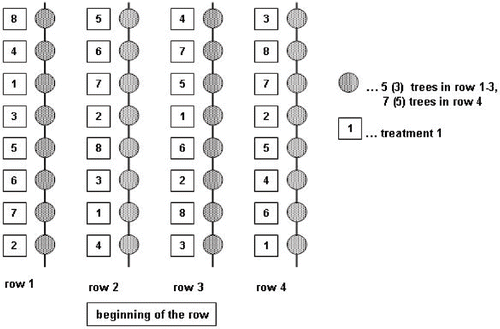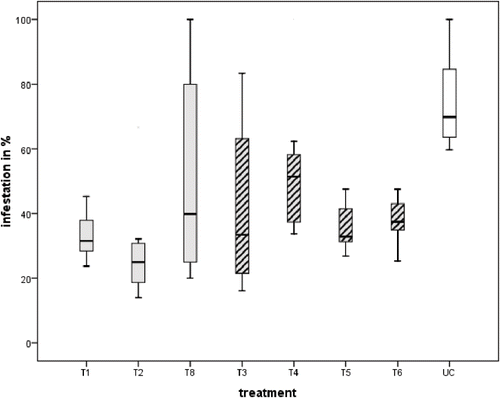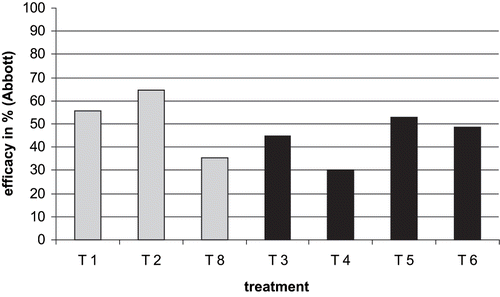Abstract
The control of the codling moth (Cydia pomonella) is becoming very difficult due to the increasing resistance of the pest, the change in climatic conditions, and the loss of plant protectant products for its efficient control. Trials of alternative control strategies against this moth were carried out in Austria in 2007. The efficacy of the four mainly used insecticides was tested according to EPPO standards. The total infestation rate reached 75% in the untreated control. All treatments obtained efficacy rates up to 64%. The results showed that more effective management strategies still have to be developed to sufficiently control the codling moth, especially in integrated production.
INTRODUCTION
The codling moth, Cydia pomonella L. (Tortricidae, Lepidoptera), is the most important pest in pome fruit production (CitationLandolt et al., 1999), and its control has become a subject of increasing importance internationally. The main reasons behind the problem are the increasing resistance of C. pomonella to plant protectant products (CitationCharmillot and Pasquier, 2002; CitationCharmillot et al., 2007; CitationSalamin et al., 2007; CitationStará and Kocourek, 2007), including virus products (CitationAsser-Kaiser et al., 2007), and the expiration of the use authorization of important plant protectant products, especially for integrated production. Changes in the geographical distribution and phenology of the codling moth due to climatic changes also have to be considered, as mentioned by CitationRafoss and Saethre (2003).
In Austria, major problems were expected from 2008 onward due to the loss of the most commonly used organophosphate insecticide against the codling moth. Therefore, trials for the development of alternative control strategies against the codling moth that are also suitable for integrated production were carried out in Austria by the Institute of Plant Health (AGES) in coordination with the chambers of agriculture of Lower Austria and Styria in 2007. The efficacy of Chlorpyrifos, and of three other comonly used insecticides with different active ingredients, were tested in this trial.
MATERIAL AND METHODS
The investigations were carried out in Lower Austria in a pome fruit orchard (∼1,000 m2) situated in Theiß, about 75 km west of Vienna. The experimental area was only a part of this pome fruit production site with ‘Jonagold’ and ‘Idared’ being used as cultivars in this study.
Four plant protection products with Fenoxycarb, Methoxyfenozid, Chlorpyrifos, and Indoxacarb as active ingredients were used in different numbers of applications and combinations (). Applications were carried out with the portable mister SOLO 423 Port (Sindelfingen, Germany), which has an air flow rate of maximum 1,300 m3 per hour. The water volume was 1,000 L per ha.
TABLE 1 Survey of the Tested Four Plant Protection Products Against C. pomonella
The trial design and layout was carried out according to the EPPO-standard PP 1/7(3) for Cydia pomonella from CitationOEPP/EPPO (2004). It consisted of eight treatments with four replicates: three treatments with combinations of plant protection products (treatments 1, 2, and 8), four treatments with one single plant protection product (treatments 3, 4, 5, and 6), and one untreated control (treatment 7). The experimental design of the investigation site is shown in .
FIGURE 1 Experimental design of the investigation site in Theiß, Austria, 2007 (1, 2, 8—combination of plant protection products, 3—Dursban 2 E, 4—Insegar 25 WP, 5—Runner, 6—Steward, 7—untreated control).

The timing of applications was based on the AGES forecasting system for C. pomonella, which includes visual and pheromone trap observations in orchards, and the “cage-method.” With the cage method, the development of a model population of the codling moth (flight of adults, egg-laying, emergence of larvae) is observed under outdoor conditions. For this purpose, several observation stations are established at different sites in Austria with the codling moth cage method on five sites for the first generation, and on three sites for the second generation, and pheromone traps on ten sites.
The different treatments against the two generations of the codling moth and the data on application are shown in the following tables. Treatments for the first generation started on May 14, 2007, before egg-laying and ended in June 13, 2007 (); treatments for the second generation started on July 3, 2007, and were finished August 16, 2007 ().
TABLE 2 Trial Treatments Against the First Generation of C. pomonella in Theiß, Austria, 2007
TABLE 3 Trial Treatments Against the Second Generation of C. pomonella in Theiß, Austria, 2007
The total trial period was from May 14 until harvest, on September 26, 2007. During this time, all infested fruits were evaluated every week. The infestation rate with codling moth larvae was assessed by counting the number of all infested and not infested dropped fruits per replicate and treatment. For statistical evaluation the percentage data of the observed infestation rates were angular transformed before processing, and the mean values of each treatment were analyzed for significant differences with a univariate ANOVA (SPSS for Windows 16.0, Win Wrap Basic, Polar Engineering and Consulting, Nikiski, AK, USA).
RESULTS
In , the infestation of all available and evaluated fruits from the whole investigation period is shown. Mean infestation rates of C. pomonella per treatment were statistically significant different between the untreated control and each of the treatments (F = 10.539, α ≤ 0.05). However, in most of the treatments, significantly different infestation rates were found between one of the four replicates to the other replicates, which were due to the presence of a different apple host plant.
FIGURE 2 Total infestation in percent (mean ± sd) of C. pomonella after different treatments including the control in Theiß, Austria, 2007 (T1, T2, T8—combination of plant protection products, T3—Dursban 2 E, T4—Insegar 25 WP, T5—Runner, T6—Steward, UC—untreated control).

The investigated pome fruit orchard showed a very high infestation level of C. pomonella, which is demonstrated with a total infestation of 75% for the untreated control plots. In each treatment, the infestation level was clearly above the economic threshold of 1% infestation. The best results were achieved with the treatments 1, 2, (different combinations of Fenoxycarb, Methoxyfenozide, and Indoxacarb) and 5 (treatment only with Methoxyfenozide), which were not significantly different from each other. Treatment 2 reached the lowest infestation rate with 26%, which is significantly different from the treatments 3, 4, 6, 7, and 8. Chlorpyrifos (treatment 3) alone showed no significant difference in the infestation level compared to the other treatments, except treatment 2 (with the lowest infestation rate) and treatment 7, the untreated control.
For all treatments, efficacy levels were below 70% (). The highest efficacy rates again were achieved for the treatments with the combinations of plant protection products (treatments 2 and 1) and the treatment with Methoxyfenozide only, which ranged from 53% to 64%. The treatment with only Fenoxycarb as an active ingredient showed the lowest efficacy.
FIGURE 3 Efficacy of treatments in percent (CitationAbbott, 1925) for the seven treatments in Theiß, Austria, 2007 (T1, T2, T8—combination of plant protection products, T3—Dursban 2 E, T4—Insegar 25 WP, T5—Runner, T6—Steward).

DISCUSSION
Two of the three treatments, including a combination of Fenoxycarb, Methoxyfenozide, and Indoxacarb, obtained lower infestation rates and higher efficacy levels than treatments with only one active ingredient for the treatments, except Methoxyfenozide. Nevertheless, no treatment was able to achieve infestation below the economic damage threshold. But in this trial, the codling moth population was very high in this orchard, as demonstrated with the high infestation level of the untreated control. With regard to the obtained results, it seems that no sufficient control of the codling moth is possible at high infestation levels with the four tested active ingredients (Chlorpyrifos, Fenoxycarb, Methoxyfenozide, and Indoxacarb), in spite of exact timing of the applications due to the AGES forecasting system.
Observations have shown that global climate change could influence the phenology of C. pomonella and could increase its occurrence (CitationMorgan, 1996). Due to warmer temperatures, especially in spring, the flight of the moth will start earlier and so more generations per year would be possible as was observed in southern Italy in 2007.
The initial codling moth population is an important factor for the moth's development and infestation. As already mentioned above, climatic conditions can also have a great influence on the C. pomonella infestation rate. In contrast to 2007, the first flight of the codling moth began much later in 2008, and most larvae of the first generation went into diapause, and the second generation appeared not only about 2 weeks later than usual, but also with less individuals. The AGES forecasting system evaluated that in 2007, only 20% of the first generation's larvae went into diapause and in 2008 about 80%. Therefore, in such years, the codling moth seems not to be a problem. But if there are any advantageous climatic conditions for C. pomonella or application mistakes in control, the moth will be able to build up high population densities, especially in the first generation. Control mistakes in the second generation will lead to late infestation and will reduce the quality of the fruit at harvest.
The trial showed that marginally effective control is dependent on the availability of production products such as Chlorpyrifos. Comparable results were also possible with the combination of different insecticides. Therefore, it appears that on the one hand, the loss of Chlorpyrifos has a decisive influence on the efficiency of control, but on the other hand, that it can be partly compensated by the combination of the remaining insecticides. Additionally, new insecticides promising good efficacy could offer new possibilities for control strategies against the codling moth.
Important preconditions for successful control of the codling moth are low infestation levels and the correct timing of spray applications, which could be reached with the help of forecasting systems. Therefore, an effective control strategy has to combine all possible control measures. Further research for effective control against the codling moth remains still necessary.
CONCLUSIONS
This trial demonstrates that, in spite of exact timing of the treatments, no treatment could reach an infestation level under the economic damage threshold. Whereas the initial codling moth population is an important factor for the development of the codling moth during a vegetation period, the influence of climatic conditions should also be taken into consideration. Observations during recent years showed that the codling moth population will increase in the future due to more hot and dry weather conditions, as is already being experienced in some European regions (e.g., in Italy). At the same time, its control will be increasingly difficult because of resistance problems with chemical and biological plant production products and their insufficient duration of efficacy. Thus, it can be concluded that more effective control strategies have to be developed to ensure the quality and quantity of pome production for the future.
ACKNOWLEDGMENTS
We are very grateful to Herbert Muster, chamber of agriculture of Styria, and Karl Bachinger, chamber of agriculture of Lower Austria, for helpful comments about the planning of the trial, and especially to Günter Dingl, the owner of the orchard, for the good cooperation.
LITERATURE CITED
- Abbott , W.S. 1925 . A method of computing the effectiveness of an insecticide . J. Econ. Entomol. , 18 : 275 – 277 .
- Asser-Kaiser , S. , Fritsch , E. , Undorf-Spahn , K. , Kienzle , J. , Eberle , K.E. , Gund , N.A. , Reineke , A. , Zebitz , C.P.W. , Heckel , D.G. , Huber , J. and Jehle , J.A. 2007 . Rapid emergence of baculovirus resistance in codling moth due to dominant, sex-linked inheritance . Science (Washington) , 317 ( 5846 ) : 1916 – 1918 .
- Charmillot , P.J. and Pasquier , D. 2002 . Increasing resistance of the codling moth Cydia pomonella to insecticides . Revue Suisse Vitic. Arboric. Hortic. , 34 ( 2 ) : 95 – 100 .
- Charmillot , P.J. , Pasquier , D. , Salamin , C. , Briand , F. , ter Hovannesyan , A. , Azizian , A. , Kutinkova , H. , Peeva , P. and Vlecheva , N. 2007 . Detection of resistance in the codling moth Cydia pomonella. Insecticides tests on diapausing larvae from Switzerland, Armenia and Bulgaria . Revue Suisse Vitic. Arboric. Hortic. , 39 ( 6 ) : 385 – 389 .
- Landolt , P.J. , Hofstetter , R.W. and Biddick , L.L. 1999 . Plant essential oils as arrestants and repellents for neonate larvae of the codling moth (Lepidoptera: Tortricidae) . Environ. Entomol. , 28 ( 6 ) : 954 – 960 .
- Morgan , D. 1996 . Temperature changes and insect pests: A stimulation study . Aspects Appl. Biol. , 45 : 277 – 283 .
- OEPP/EPPO . 2004 . EPPO Standards PP1, Efficacy evaluation of plant production products, Vol. 3, insecticides and acaricides , 4 – 6 . Paris : OEPP/EPPO .
- Rafoss , T. and Saethre , M.G. 2003 . Spatial and temporal distribution of bioclimatic potential for the codling moth and the Colorado potato beetle in Norway: Model predictions versus climate and field data from the 1990s . Agr. Forest Entomol. , 5 ( 1 ) : 75 – 85 .
- Salamin , C. , Charmillot , P.J. , Pasquier , D. and Peeva , P. 2007 . Efficacy of codling moth (Cydia pomonella) granulosis virus applied by dipping of apples. Revue Suisse Vitic . Arboric. Hortic. , 39 ( 3 ) : 207 – 209 .
- Stara , J. and Kocourek , F. 2007 . Insecticidal resistance and cross-resistance in populations of Cydia pomonella (Lepidoptera: Tortricidae) in Central Europe . J. Econ. Entomol. , 100 ( 5 ) : 1587 – 1595 .